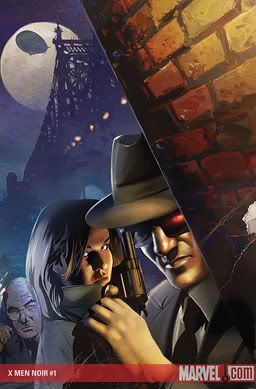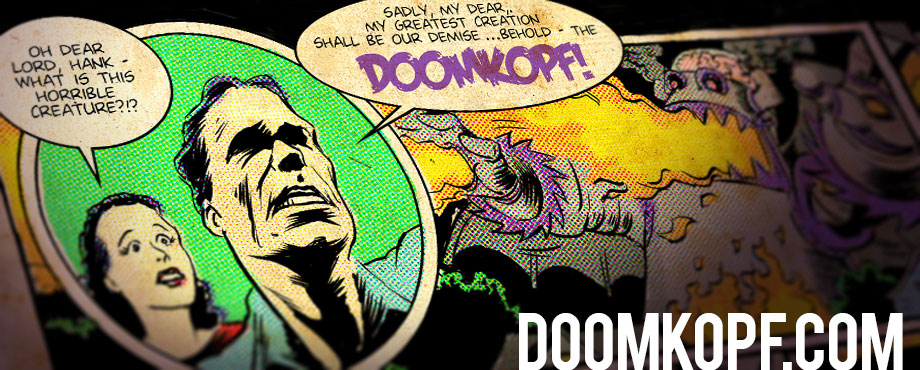X-Men Noir #1
 The line between gimmick story and fun storytelling isn’t always obvious. Much like a television series, transposing your characters to another place and time can end up like “1602,” or it could be any of the numerous holodeck malfunction episodes of “Star Trek: The Next Generation.”
The line between gimmick story and fun storytelling isn’t always obvious. Much like a television series, transposing your characters to another place and time can end up like “1602,” or it could be any of the numerous holodeck malfunction episodes of “Star Trek: The Next Generation.”
So I had apprehension about “X-Men Noir.” In fact, I was not going to pick up the book in the least. But I was won over by the persuasive power of Doom DeLuise, who manages to convince me into a variety of things, good and bad.
Oh yeah, I’m about to unleash a huge amount of spoilers, so don’t read on if you’re not into that. I’m putting it in quotes so you can just scroll down to the review.
“Noir” opens with a detective story … a woman face down and dead, dismembered by an unknown assailant, three claw marks in her back. The woman turns out to be Jean Grey. A detective Dukes and his rookie Peter discuss it, and Dukes points it to the work of a reform school run by Charles Xavier. The X-Men are said to be an evil organization, and the red X on Grey’s person is the calling card for Dukes to give up on the case. Peter, on the other hand, does not. He decides to investigate further.
We jump to a casino owned by Remy LeBeau, being visited by a debutante by the name of Thomas Halloway. A quick Wikipedia search revealed him to be the golden age Angel. Interesting. But anyway, LeBeau’s strong-arm, Bishop, attempts an assault on a Ms. Magnus, who Halloway saves. She mentions being the Chief-of-Detectives daughter as the two stroll back in.
Halloway, it turns out, is also a Daily Bugle reporter. He ends up in prison, visiting the incarcerated Charles Xavier to talk about his school and the Grey case. In his hands, he’s got the science fiction stories of Bolivar Trask, foretelling of great Sentinels (the excerpts of which are at the back of the book.) Xavier refers to his students as the “Sociopaths” … and his research lost him his membership in the American Psychological Association. When the on-duty officer cuts the visit short, Halloway is left with a clue by Xavier … “Find Marie Rankin.” Could this be Rogue, or a relative to Calvin Rankin, the on-and-off-again Mimic who veers between good and bad?
Dukes and Peter end up in a bar, where the crowd celebrates Dukes’ arrival. He leads Peter down to a basement where the police have bound a “Blackie” Cassidy. The police chief tells him to move along his cartel out of the good neighborhood, and to the soon-to-be-demolished slums. The chief tells Peter that the law is for the law abiding, but for the criminals, there’s the Brotherhood. Peter runs away in horror.
Next, we have Halloway breaking and entering to the file room of the Xavier School, grabbing the file of Anna Marie Rankin (yep, probably Rogue.) He’s ambushed by Angel, Beast and Cyclops. He tells them he’s on their side, to which Cyclops replies “Haven’t you heard, chum? We’re the X-Men. Nobody’s on our side.
All in all, it’s an entertaining beginning, deciding to reinvent with wild abandon and throw itself fully into this noir world. As a fan of some of the original noir films, it seems to get the tone right, though it’s not exactly treading new ground. Like many of these displaced time stories, it seems to have the basic ideas down of what it wants to do, but is transposing the original element (the X-Men) into a well-worn framework, and letting the characters themselves tread the new ground. This is where the novelty element of these stories becomes dangerous, because the story ends up exactly what we thought … and thus, too by the books to be anything but fun. And some of the times, these end up not a lot of fun.
However, as what I hope is just the set-up, the story wins. The homages are clever, the mystery being the dynamic of the world we’re working within. DDL introduced this to me as the “new 1602,” or so he had heard. So far, it’s got the promise to end up as fun as that series.
But in the end, I hope this series is successful and good, because it can set a precedence. For too long, Marvel has gone with the “What If?” route when it should have done the Elseworlds. “1602” was the start to something more, but I worry that this will end up trying to connect it back to the mainstream Marvel reality, which would be a huge detriment to the series. Instead, we should let stories like this stay self-contained, allowing authors to use the archetypes and have some real fun from there. Think “Powerless.”
We’ll see how this story goes, but so far, it has potential so long as it stays away from some of the traps that befall some of these stories.
